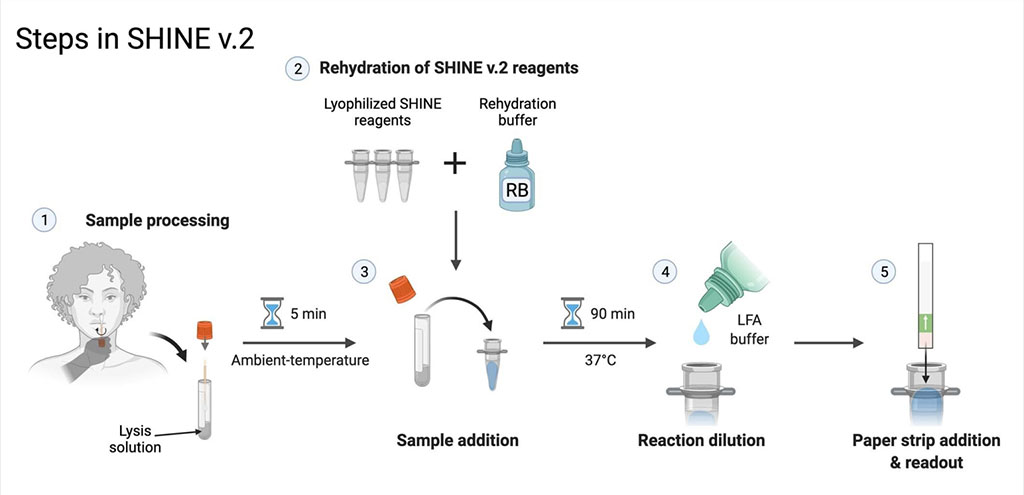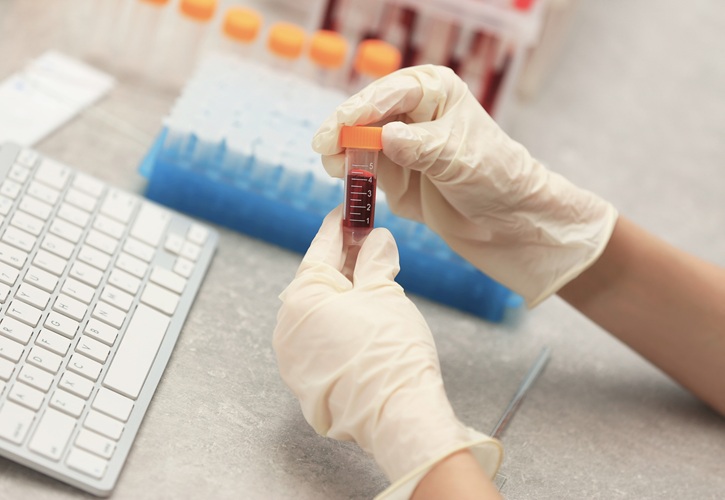Equipment-Free Diagnostic Test Enables Detection of SARS-CoV-2 and Variants at POC
|
By LabMedica International staff writers Posted on 17 Aug 2022 |

More than two years into the pandemic, the virus that causes COVID—SARS-CoV-2—continues to spread worldwide. Testing for the virus and its variants can help limit transmission and inform treatment decisions, and is therefore an important pillar of the public health response. Now, researchers have created an easy-to-use diagnostic test for COVID infection that is more sensitive than the commonly used at-home antigen tests, and that also allows for the rapid and specific detection of SARS-CoV-2 variants in point-of-care settings.
The improved test developed by a team of researchers from Princeton University (Princeton, NJ, USA) and the Broad Institute of MIT and Harvard (Cambridge, MA, USA) detects virus using a different mechanism than the more familiar clinic-based PCR or at-home antigen tests. Instead, the test detects virus using a technology known as CRISPR, which has found widespread use in gene editing. CRISPR originated from a system used by bacteria to detect and defend against viral infections, and is uniquely suited to rapidly identifying specific genetic sequences.
The researchers had earlier developed develop a CRISPR-based test that could be tailored to diagnose specific viral infections. In the wake of the pandemic’s first wave in 2020, the team modified their test, which they called SHINE, to detect SARS-CoV-2 with remarkable sensitivity. In a collaborative effort to improve SHINE, the group first focused on eliminating the need for specialized equipment to prepare patient samples for testing. Next, they optimized the test so that its reagents don’t need to be kept in a freezer, which ensures that the test can be easily transported long distances.
They dubbed the improved test “SHINEv.2.” After confirming that the altered test worked well in their own laboratory, the group sent a test kit to a laboratory in Nigeria to see whether it could survive a long period in transit and still retain its accuracy and sensitivity. It did. But then a new challenge arose for the team to address – the emergence of new SARS-CoV-2 variants. The team was able to quickly adapt SHINEv.2 to discern between infections mounted by the Alpha, Beta, Delta or Omicron SARS-CoV-2 variants in patient samples, and say the test can be rapidly modified to pick up on any other variants that may arise.
Because it tests for the different variants all at once, this version of the test needs one special, but relatively inexpensive, piece of equipment to read out its results. Nonetheless, SHINEv.2 is much faster to perform, and requires much less equipment and expertise, than current approaches used to identify SARS-CoV-2 variants. The team envisions that it would mainly be used at doctors’ offices, even ones with limited resources in remote locations, to help physicians determine which viral variant is afflicting their patient, and tailor therapies appropriately.
“The data indicating this approach can be used to distinguish SARS-CoV-2 variants of concern by differential detection of genomic mutations could enable us to better prepare for the appearance of the next mutation,” said Tony Hu, director of the Center for Intelligent Molecular Diagnostics and Weatherhead Presidential Chair at Tulane University, who reviewed the manuscript for Nature Biomedical Engineering. “The approach reported by authors could be a significant contribution for pandemic control by providing a method that requires minimal sample processing or heating.”
Related Links:
Princeton University
Broad Institute of MIT and Harvard
Latest COVID-19 News
- New Immunosensor Paves Way to Rapid POC Testing for COVID-19 and Emerging Infectious Diseases
- Long COVID Etiologies Found in Acute Infection Blood Samples
- Novel Device Detects COVID-19 Antibodies in Five Minutes
- CRISPR-Powered COVID-19 Test Detects SARS-CoV-2 in 30 Minutes Using Gene Scissors
- Gut Microbiome Dysbiosis Linked to COVID-19
- Novel SARS CoV-2 Rapid Antigen Test Validated for Diagnostic Accuracy
- New COVID + Flu + R.S.V. Test to Help Prepare for `Tripledemic`
- AI Takes Guesswork Out Of Lateral Flow Testing
- Fastest Ever SARS-CoV-2 Antigen Test Designed for Non-Invasive COVID-19 Testing in Any Setting
- Rapid Antigen Tests Detect Omicron, Delta SARS-CoV-2 Variants
- Health Care Professionals Showed Increased Interest in POC Technologies During Pandemic, Finds Study
- Set Up Reserve Lab Capacity Now for Faster Response to Next Pandemic, Say Researchers
- Blood Test Performed During Initial Infection Predicts Long COVID Risk
- Low-Cost COVID-19 Testing Platform Combines Sensitivity of PCR and Speed of Antigen Tests
- Finger-Prick Blood Test Identifies Immunity to COVID-19
- Quick Test Kit Determines Immunity Against COVID-19 and Its Variants
Channels
Clinical Chemistry
view channel
Carbon Nanotubes Help Build Highly Accurate Sensors for Continuous Health Monitoring
Current sensors can measure various health indicators, such as blood glucose levels, in the body. However, there is a need to develop more accurate and sensitive sensor materials that can detect lower... Read more
Paper-Based Device Boosts HIV Test Accuracy from Dried Blood Samples
In regions where access to clinics for routine blood tests presents financial and logistical obstacles, HIV patients are increasingly able to collect and send a drop of blood using paper-based devices... Read moreMolecular Diagnostics
view channel
Blood Test Identifies Multiple Biomarkers for Rapid Diagnosis of Spinal Cord Injury
The National Institutes of Health estimates that 18,000 individuals in the United States sustain spinal cord injuries (SCIs) annually, resulting in a staggering financial burden of over USD 9.... Read more
Highly Accurate Blood Test Diagnoses Alzheimer’s and Measures Dementia Progression
Several blood tests are currently available to assist doctors in diagnosing Alzheimer's disease in individuals experiencing cognitive symptoms. However, these tests do not provide insights into the clinical... Read more
Simple DNA PCR-Based Lab Test to Enable Personalized Treatment of Bacterial Vaginosis
Approximately one in three women aged 14-49 in the United States will experience bacterial vaginosis (BV), a vaginal bacterial imbalance, at some point in their lives. Around 50% of BV cases do not present... Read moreHematology
view channel
New Scoring System Predicts Risk of Developing Cancer from Common Blood Disorder
Clonal cytopenia of undetermined significance (CCUS) is a blood disorder commonly found in older adults, characterized by mutations in blood cells and a low blood count, but without any obvious cause or... Read more
Non-Invasive Prenatal Test for Fetal RhD Status Demonstrates 100% Accuracy
In the United States, approximately 15% of pregnant individuals are RhD-negative. However, in about 40% of these cases, the fetus is also RhD-negative, making the administration of RhoGAM unnecessary.... Read moreImmunology
view channel
Post-Treatment Blood Test Could Inform Future Cancer Therapy Decisions
In the ongoing advancement of personalized medicine, a new study has provided evidence supporting the use of a tool that detects cancer-derived molecules in the blood of lung cancer patients years after... Read more
Cerebrospinal Fluid Test Predicts Dangerous Side Effect of Cancer Treatment
In recent years, cancer immunotherapy has emerged as a promising approach where the patient's immune system is harnessed to fight cancer. One form of immunotherapy, called CAR-T-cell therapy, involves... Read more
New Test Measures Preterm Infant Immunity Using Only Two Drops of Blood
Preterm infants are particularly vulnerable due to their organs still undergoing development, which can lead to difficulties in breathing, eating, and regulating body temperature. This is especially true... Read more
Simple Blood Test Could Help Choose Better Treatments for Patients with Recurrent Endometrial Cancer
Endometrial cancer, which develops in the lining of the uterus, is the most prevalent gynecologic cancer in the United States, affecting over 66,000 women annually. Projections indicate that in 2025, around... Read moreMicrobiology
view channel
Breakthrough Diagnostic Technology Identifies Bacterial Infections with Almost 100% Accuracy within Three Hours
Rapid and precise identification of pathogenic microbes in patient samples is essential for the effective treatment of acute infectious diseases, such as sepsis. The fluorescence in situ hybridization... Read more
Innovative ID/AST System to Help Diagnose Infectious Diseases and Combat AMR
Each year, 11 million people across the world die of sepsis out of which 1.3 million deaths are due to antibiotic-resistant bacteria. The burden of antimicrobial resistance (AMR) continues to weigh heavily,... Read more
Gastrointestinal Panel Delivers Rapid Detection of Five Common Bacterial Pathogens for Outpatient Use
Acute infectious gastroenteritis results in approximately 179 million cases each year in the United States, leading to a significant number of outpatient visits and hospitalizations. To address this, a... Read morePathology
view channel
AI Model Predicts Patient Response to Bladder Cancer Treatment
Each year in the United States, around 81,000 new cases of bladder cancer are diagnosed, leading to approximately 17,000 deaths annually. Muscle-invasive bladder cancer (MIBC) is a severe form of bladder... Read more
New Laser-Based Method to Accelerate Cancer Diagnosis
Researchers have developed a method to improve cancer diagnostics and other diseases. Collagen, a key structural protein, plays various roles in cell activity. A novel multidisciplinary study published... Read more
New AI Model Predicts Gene Variants’ Effects on Specific Diseases
In recent years, artificial intelligence (AI) has greatly enhanced our ability to identify a vast number of genetic variants in increasingly larger populations. However, up to half of these variants are... Read more
Powerful AI Tool Diagnoses Coeliac Disease from Biopsy Images with Over 97% Accuracy
Coeliac disease is an autoimmune disorder triggered by the consumption of gluten, causing symptoms such as stomach cramps, diarrhea, skin rashes, weight loss, fatigue, and anemia. Due to the wide variation... Read moreTechnology
view channel
Smartphones Could Diagnose Diseases Using Infrared Scans
Rapid advancements in technology may soon make it possible for individuals to bypass invasive medical procedures by simply uploading a screenshot of their lab results from their phone directly to their doctor.... Read more
Novel Sensor Technology to Enable Early Diagnoses of Metabolic and Cardiovascular Disorders
Metabolites are critical compounds that fuel life's essential functions, playing a key role in producing energy, regulating cellular activities, and maintaining the balance of bodily systems.... Read more
3D Printing Breakthrough Enables Large Scale Development of Tiny Microfluidic Devices
Microfluidic devices are diagnostic systems capable of analyzing small volumes of materials with precision and speed. These devices are used in a variety of applications, including cancer cell analysis,... Read moreIndustry
view channelLeica Biosystems and Bio-Techne Expand Spatial Multiomic Collaboration
Bio-Techne Corporation (Minneapolis, MN, USA) has expanded the longstanding partnership between its spatial biology brand, Advanced Cell Diagnostics (ACD, Newark, CA, USA), and Leica Biosystems (Nussloch,... Read more
Philips and Ibex Expand Partnership to Enhance AI-Enabled Pathology Workflows
Royal Philips (Amsterdam, The Netherlands) has expanded its partnership with Ibex Medical Analytics (Tel Aviv, Israel) and released the new Philips IntelliSite Pathology Solution (PIPS) to further accelerate... Read more
Grifols and Inpeco Partner to Deliver Transfusion Medicine ‘Lab of The Future’
Grifols (Barcelona, Spain), a manufacturer of plasma-derived medicines and innovative diagnostic solutions, has entered into a strategic agreement with Inpeco (Novazzano, Switzerland), a global leader... Read more



















